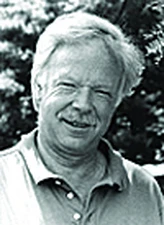James D. Hays

The 2010 Milutin Milanković Medal is awarded to James D. Hays for his pioneering, fundamental and continuous work on the reconstruction of Cenozoic climates and for his Science 1976 seminal paper on the astronomical theory of palaeoclimates.
James D. Hays, Columbia University Ph.D. 1964, spent the late 60’s developing, in cooperation with Lamont colleagues, a chronostratigraphic framework for deep-sea sediments by connecting the land-dated record of Earth’s magnetic field reversals with marine stratigraphic datums. This established a near-global, Plio-Pleistocene chronology for deep-sea sediments and recognized and dated for the first time the 100K-year climate cycle. By 1970 Hays realized that this marine chronostratigraphy, combined with the Imbrie-Kipp technique, which transforms marine microfossil assemblage data into estimates of past sea surface temperature, if applied to the extensive Lamont Core collection, could form the basis of a global study of Pleistocene climates. He asked John Imbrie to join the Lamont group and the CLIMAP project was born. Hays then asked Nick Shackelton to join CLIMAP and generate an oxygen isotope record of benthic and planktonic microfossils in a Pacific core. From this work Shackelton and Opdyke showed that the marine oxygen isotopic record is dominated by changes in the isotopic composition of seawater, caused by the waxing and waning of the great ice sheets. This near synchronous isotopic signal was then used by CLIMAP to correlate calcareous records, further refine the dating of biostratigraphic datums and when correlated with siliceous indicators, extend time control to non-calcareous sediments. This allowed the construction of global maps of past sea surface temperature at specific times. It was this careful pre-CLIMAP and early CLIMAP chronostratigraphic work that allowed Hays, Imbrie and Shackelton to show, through analyses in both the frequency and time domains, that Earth’s orbital variations control the timing of climate change on ice age time scales, proving the theory that Milankovitch contributed so much to developing. This paper and subsequent papers extended temporal information, provided by calculations of orbital variations, to the marine record of the last 730,000 years and set in motion work, to date, much of the Cenozoic marine record. In addition Hays published papers on plate tectonics, including one with Walter Pitman demonstrating that changes in oceanic ridge volumes, caused by ridge spreading rate changes, contribute to major eustatic sea level changes and were responsible for one of these important geological events in late Mesozoic and Cenozoic time. He has published on the evolution of marine microfossils, and lead the development of an undergraduate Earth System Science curriculum that teaches students how to extract information about Earth processes, through the analysis of large geophysical and geochemical data sets, which is now used across the United States. Currently he is using deep- and shallow-living radiolarians to measure past changes in the efficiency of the oceans Biological Pump. Although the time series of both are dominated by orbital frequencies, interestingly, their frequency emphasis is different.
Recognizing the potential mutual benefits of joint efforts with European research groups, Hays has long sought collaboration with European colleagues, an effort which has produced successful cooperation, for example, with Professors Siebold (Kiel), Van der Hammen (Amsterdam), Dansgaard (Copenhagen), and Lamb (East Anglia). In addition, young scientists from Professor Siebold’s group (e.g. Hans Thierstien, Hans Schrader, Bjorn Thiede and Michael Sarnthein) have gone to the US to work with CLIMAP. Later Jean-Claude Duplessy and André Berger joined the effort. Hays has presented papers at 4 of the 5 EGU General Assemblies and contributed to General Assemblies of the former EGS. He is the recipient of the Bownacker Research Award from the Ohio State University.
